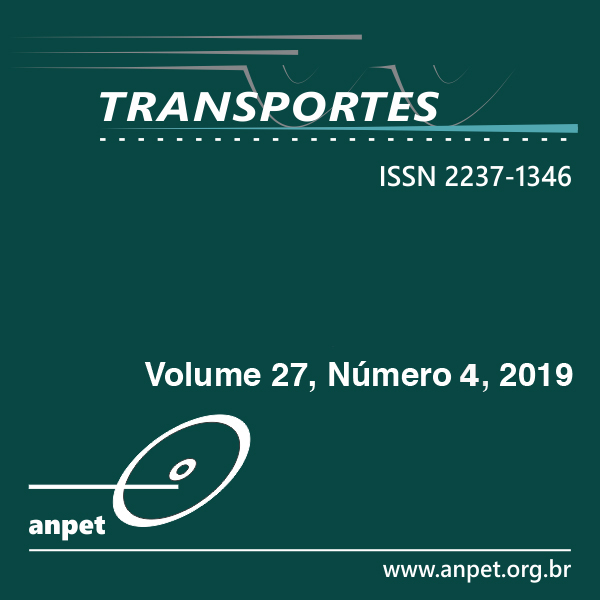Utilização de métodos de previsão da velocidade de ocorrência de aquaplanagem para verificação da segurança em rodovias de alto padrão
DOI:
https://doi.org/10.14295/transportes.v27i4.1735Keywords:
Aquaplaning, Road safety, Tire-pavement interface.Abstract
This work presents a summary of existing methods to predict hydroplaning speed limits and it highlights the risks associated with this phenomenon. Based on the assessment of the probability of occurrence of this phenomenon in different scenarios, the work identifies the need for the development of complementary criteria and recommendations for projects in Brazil. A case study is undertaken to assess the proposed methodologies on a hypothetical highway section that combines typical high standards highway conditions and located in the Metropolitan Region of São Paulo.Downloads
References
Agrawall, S. K.; Meyer, W. E.; J.J., H. (1977) Measurement of hydroplaning potential. Pennsylvania Tranportation Institute, Penn-sylvania State University, PA, USA: [s.n.].
Ariawan, I. M. A.; Subagio, B. S.; Setiadji, B. H. (2015) Development of asphalt pavement temperature model for tropical cli-mate conditions in West Bali region. The 5th International Conference of Euro Asia Civil Engineering Forum (EACEF-5). [S.l.]: [s.n.]. p. 474-480.
Browne, A. L. (1975) A Mathematical Analysis for Pneumatic Tire Hydroplaning. Surface Texture Versus Skidding: Measure-ments, Frictional Aspects and Safety Features of Tire-Pavement Interactions, ASTM STP 583, p. 75-94.
Cogresso Nacional. (1997) Código de Trânsito Brasileiro. Brasília: [s.n.].
Gallaway, B. M. et al. (1979) Pavement and geometric design criteria for minimizing Hydroplanning, Report No. FHWARD-79-31. Washington, DC, USA: Federal Highway Administration.
Gengenbach, W. (1967) Das Verhalten von Kraftfahrzeugreifen auf trockener und insbesondere auf nasser Fahrbahn. Karlsruhe: Fakultät für Maschinenbau und Verfahrenstechnik der Universität Karlsruhe.
Gothié, M. (2005) Water influence on skid resistance - Standardization: input of the HERMES programme. International Surface Friction Conference: roads and runways: improving safety through assessment and design. Christchurch, New Zealand : [s.n.]. p. 50.
Gunatne, M. et al. (2012) Hydroplaning on multi lane facilities, Report No. BDK84 977-14. FHWA. University of South Florida, Tampa, FL, p. 130.
Herrmann, S. R. (2008) Simulationsmodell Zum Wasserabfluss- Und Aquaplaning-Verhalten Auf Fahrbahnoberflächen. Stuttgart: Universität Stuttgart Institut für Straßen- und Verkehrswesen.
Hocker, H. J. (1971) Die Oberflächenentwässerung von Fahrbahnen und ihre Bedeutung für den Straßenentwurf. Aachen: Bundes-minister für Verkehr, Abteilung Straßenbau.
Horne, W. B.; Dreher, R. C. (1963) Phenomena of pneumatic tire hydroplaning. Langley Research Center, Langley Station, Wash-ington D.C.: National Aeronautics and Space Administration.
Horne, W. B.; Yager, T. J.; Ivey, D. L. (1986) Recent Studies to Investigate Effects of Tire Footprint Aspect Ratio on Dynamic Hidroplaning Speed. The Tire Pavement Interface, ASTM STP 929, Philadelphia, p. 22-46.
Horne, W. B.; Yager, T. J.; Taylor, G. R. (1968) Review Of Causes And Alleviation Of Low Tire Traction On Wet Runways. Washing-ton, DC: National Aeronautics and Space Administration.
Instituto de astronomia, geofísica e ciências atmosféricas. (2016) Dados horários de precipitação 2000-2015. Universidade de São Paulo. São Paulo, SP.
Ivey, D. L.; Lehtipuu, E. K.; Button, W. (1975) Rainfall and Visibility - The view from behind the wheel. Texas Transportation Institute. College Station, TX, p. 51.
Nhcrp. (1998) Improved surface drainage of pavements (Project 1-29 Final Report). Washington, D.C.: Transportation Review Board.
Ong, G. P.; Fwa, T. F. (2007) Wet-pavement hydroplaning risk and skid resistance: modeling. ASCE Journal of transportation Engineering, v. 133, n. 10.
Ong, G. P.; Fwa, T. F. (2008) Modeling and analysis of truck hydroplaning on highways. Transportation Research Record, Wash-ington, D.C., n. 2068, p. 99-108.
Ross, N. F.; Russam, K. (1968) The depth of rain water on road surfaces. London: Ministry of Transport.
Sheridan, L. (2014) Aquaplaning: an investigation of surface flow calculation. Darling Heights: University of South Queensland.
Subramanian, R.; Thiriez, K. (2001) Tire Pressure Special Study Tread Depth Analysis. National Center for Statistics and Analy-sis of the National Highway Traffic Safety Administration. Washington, D.C.
Transportation Research Board. (2010) Highway Capacity Manual. Washington, D.C: [s.n.].
Downloads
Published
How to Cite
Issue
Section
License
Authors who submit papers for publication by TRANSPORTES agree to the following terms:
- The authors retain the copyright and grant Transportes the right of first publication of the manuscript, without any financial charge, and waive any other remuneration for its publication by ANPET.
- Upon publication by Transportes, the manuscript is automatically licensed under the Creative Commons License CC BY 4.0 license. This license permits the work to be shared with proper attribution to the authors and its original publication in this journal.
- Authors are authorized to enter into additional separate contracts for the non-exclusive distribution of the version of the manuscript published in this journal (e.g., publishing in an institutional repository or as a book chapter), with recognition of the initial publication in this journal, provided that such a contract does not imply an endorsement of the content of the manuscript or the new medium by ANPET.
- Authors are permitted and encouraged to publish and distribute their work online (e.g., in institutional repositories or on their personal websites) after the editorial process is complete. As Transportes provides open access to all published issues, authors are encouraged to use links to the DOI of their article in these cases.
- Authors confirm they have obtained all required employer permissions for the publication and CC BY 4.0 licensing of the manuscript, particularly if the employer holds any claim to the manuscript's copyright. Authors assume all responsibility for employer-related copyright issues, releasing ANPET and Transportes from any related liability.
- Authors assume full responsibility for the content of the manuscript, including the necessary and appropriate authorizations for the disclosure of collected data and obtained results, releasing ANPET and Transportes from any responsibility in this regard.
Last update: 11/27/2025











